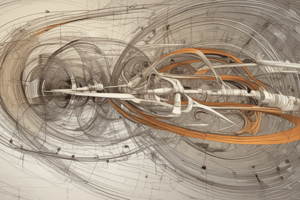Podcast
Questions and Answers
What is the value of the coefficient of restitution for a perfectly elastic collision?
What is the value of the coefficient of restitution for a perfectly elastic collision?
- 0.5
- 1 (correct)
- 0
- 2
In a central impact, what important property is conserved?
In a central impact, what important property is conserved?
- Angular momentum about the center of mass (correct)
- Total energy
- Kinetic energy of the bodies
- Linear momentum
What is the condition for translational equilibrium?
What is the condition for translational equilibrium?
- The object experiences angular acceleration.
- The vector sum of all external forces is zero. (correct)
- The net torque is not zero.
- The object is static and does not move.
Which of the following best describes an eccentric impact?
Which of the following best describes an eccentric impact?
How is impulse mathematically expressed in the impulse-momentum equation?
How is impulse mathematically expressed in the impulse-momentum equation?
Which statement accurately describes the coefficient of restitution?
Which statement accurately describes the coefficient of restitution?
What does Hooke's Law state about the force exerted by a spring?
What does Hooke's Law state about the force exerted by a spring?
What does rotational equilibrium imply about a body's angular motion?
What does rotational equilibrium imply about a body's angular motion?
What does the negative sign in the work done by a spring indicate?
What does the negative sign in the work done by a spring indicate?
In which type of impact do two bodies collide head-on with velocities along the line of impact?
In which type of impact do two bodies collide head-on with velocities along the line of impact?
What is the result of integrating Hooke's Law to find the work done by a spring?
What is the result of integrating Hooke's Law to find the work done by a spring?
What characterizes a body in dynamic equilibrium?
What characterizes a body in dynamic equilibrium?
Which type of impact occurs when velocities are aligned directly along the line of impact?
Which type of impact occurs when velocities are aligned directly along the line of impact?
Which of the following best describes dynamic equilibrium?
Which of the following best describes dynamic equilibrium?
What is the integral of force over time referred to as?
What is the integral of force over time referred to as?
What occurs during a collision characterized by a coefficient of restitution less than one?
What occurs during a collision characterized by a coefficient of restitution less than one?
Varignon's Theorem is particularly useful for simplifying calculations involving what?
Varignon's Theorem is particularly useful for simplifying calculations involving what?
In a condition where an object's net force is zero, but it has non-zero angular velocity, the object is said to be in what state?
In a condition where an object's net force is zero, but it has non-zero angular velocity, the object is said to be in what state?
What does it mean if the net torque acting on a body is not zero?
What does it mean if the net torque acting on a body is not zero?
Which type of impact occurs when two objects collide at an angle rather than head-on?
Which type of impact occurs when two objects collide at an angle rather than head-on?
Flashcards are hidden until you start studying
Study Notes
Work-Energy Equation for Translation
- Work done on an object in translational motion is the product of the applied force and displacement in the direction of that force.
Dynamic Equilibrium of a Body
- A body is in dynamic equilibrium when both translational and rotational equilibria are maintained while experiencing forces and torques.
Translational Equilibrium
- The vector sum of all external forces on the body is zero, leading to no acceleration in any direction.
Rotational Equilibrium
-
The vector sum of all external torques acting on the body is zero, preventing angular acceleration and maintaining constant angular velocity.
-
Dynamic equilibrium indicates the body can be in motion with a constant velocity, not necessarily at rest.
Impact Types in Collisions
Direct Impact
- Involves two bodies colliding head-on, with initial velocities directed along the line of impact, resulting in a significant transfer of linear momentum.
Coefficient of Restitution
- Denoted as 'e', measures the elasticity of a collision.
- Expressed as the ratio of final relative velocity to initial relative velocity; ranges from 0 (perfectly inelastic) to 1 (perfectly elastic).
Line of Impact
- An imaginary line connecting the centers of colliding bodies, crucial for analyzing collision outcomes.
Oblique Impact
- Collision occurs at an angle, not directly along the line of impact; requires consideration of both linear and angular motion components.
Central Impact
- The line of impact passes through the center of mass of both bodies, conserving angular momentum and simplifying collision analysis.
Eccentric Impact
- The line of impact does not pass through the center of mass of at least one body, affecting both linear and angular momentum, necessitating analysis of mass distribution.
Impulse-Momentum Equation
- Derived from Newton's second law, relating net force to the change in momentum over time.
- Impulse (J) equals the change in momentum (Δp), providing a crucial link in analyzing collisions and interactions.
Work Done by a Spring
- Describes energy transfer during the compression or stretching of a spring, which stores potential energy.
Hooke's Law
- Relates the force exerted by a spring (F) to its displacement (x) from equilibrium: F = -kx.
Definition of Work
-
Work (W) done is calculated as the product of force and displacement: W = ∫Fd(x).
-
Substituting Hooke's Law into the work equation gives W = -(1/2)kx², indicating the work is proportional to the square of the displacement.
-
Work done on a spring is interpreted as energy stored as potential energy, later converted back to kinetic energy when the spring returns to equilibrium.
Varignon's Theorem
- A technique in structural analysis and engineering that simplifies calculations of moments, useful for scenarios where forces are misaligned with coordinate axes.
Studying That Suits You
Use AI to generate personalized quizzes and flashcards to suit your learning preferences.





